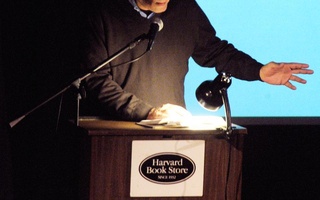In 1851 Gustave Courbet painted “A Burial at Ornans,” an enormous depiction of a country funeral, with cloaked townsfolk surrounding a priest and an open grave. Its classical style and enormous size all smacked of historical and religious importance; but Courbet’s choice to depict an everyday, contemporaneous funeral set in a rural area found modernity through an exultation of the commonplace. The painting itself was a radical upending of hierarchies. Courbet demonstrated the self-consciousness that sets modernism apart: a form of expression that, even as it acknowledges its tradition, eschews it.
Such self-consciousness is the mark of much modern writing as well—quite notably, that of Paul Auster. Auster is a master of metafiction, writing about stories and within stories, writing about writers and the act of writing. From his initial success with 1987’s “New York Trilogy” to more recent novels like 2004’s “Oracle Night” and now with “Invisible,” Auster continues to surround his novels’ protagonists in layers of text.
Auster’s concern is in the self-conscious depiction of the confusion of his characters; digging through books and words and letters to find truth, to find something—to find themselves. The protagonist of “Invisible,” Adam Walker, does just this; he looks for himself in Paris and looks at himself in letters. His quest is one of identity, but strangely, Auster’s almost simplistic prose leaves Walker as effervescent and fleeting as the novel itself.
The novel’s narrative mirrors the character’s existential crisis: Walker’s point of view (one among three) varies from first- to third-, and even second-person. The story opens in the first-person, from Walker’s perspective, on the streets of New York City in 1967: a student and writer at Columbia University, Walker meets at a party the inscrutable Rudolf Born—a professor who soon thereafter offers to finance a literary magazine that would have Walker at its helm. This role provides Walker with a definitive, if transient, identity—as he realizes: “It was the first time I had dressed up in months, and there I was, Mr. Important himself, walking across the Columbia campus with an enormous bouquet of flowers in my right hand, on my way to eat and talk business with my publisher.” This first part of the novel, we later learn, is a manuscript mailed to the second narrator: James Freeman, Walker’s college friend. This flourish of ‘infinite regress’ emphasizes Walker’s quest, 40 years later, to find who he was and who he is in paper and ink.
Auster continues exploring Walker’s past: a shocking tragedy that changes him and his perception of himself, then his sexual exploits in New York and Paris, and later interactions with Born that bring the truth into a somewhat brighter—though still dim—light. This truth is found in the fourth section, in a combination of Freeman’s words and the diary of a third character that highlights the layers of text that obscure Walker’s identity.
But the second and third parts of the novel, entitled “Summer” and “Fall” respectively, are written by Walker himself and edited by Freeman. It’s here that the narrative person-shifts take place; Walker, after finding himself stuck, follows Freeman’s advice: “By writing about myself in the first person, I had smothered myself and made myself invisible, had made it impossible for me to find the thing I was looking for. I needed to separate myself from myself.” Walker’s literary distance—within the context of these self-conscious sections—helps him look for himself in darkly tinged sexuality and self-revelation.
But this quest for identity is thwarted by Auster’s empty prose. Clichéd phrases, like “That’s the way I am. Life is too short for dawdling” and “What about me? Haven’t these days meant anything for you?” and “She taught me not to be afraid of myself anymore” leave Walker and his fellow characters trapped in two dimensions. This stands in opposition, however, to the time and space Walker traverses—in such a multilayered, diligently designed novel, clichés seem strangely out of place. Perhaps, then, their presence is meant to highlight the futility of Walker’s quest for identity: can words and letters encompass the self? The soul? “Invisible” seems to suggest that they cannot, for at the novel’s end, Walker is flat and therefore fleeting, and a style that mirrors structure doesn’t excuse Auster’s seemingly lazy language.
More than that, however, the novel remains plot-oriented; words are at the service of furthering the plot and not artistry. Vladimir Nabokov once wrote that a major writer is simultaneously a storyteller, teacher, and enchanter, and though Auster has the first two mastered— Auster can weave intricate tales that span decades and miles—he is only halfway to enchantment in “Invisible.” His fascinating dance between past and present helps him approach this ideal, but “Invisible” has no moments of literary magic, or of any real beauty. And it’s not because the words themselves are simple, but instead because they are used so formulaically, without experiment. There is plot, there is description—but there is no poetry; and so the novel itself, like Walker, melts away.
This melting, however, doesn’t obscure the fact that Auster is a master of crafting intricate tales within tales. His novels are supremely readable and enticing. But even though his characters search for identity, like Walker in “Invisible,” they remain just that—invisible. Like Courbet, Auster has managed to create a work of art out of the awareness of tradition. He just never manages to break from it.
Read more in Arts
'Sorcerer' Conjures Whimsical Fun















